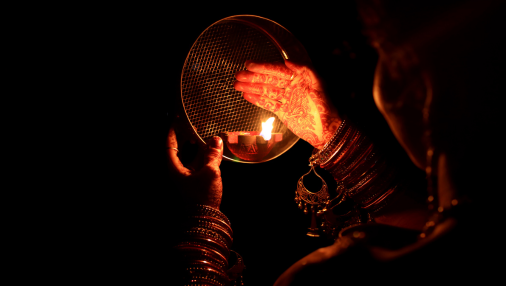The Historical and Cultural Significance of Karva Chauth
Karva Chauth has been observed for centuries and finds mention in a variety of ancient folk tales and traditions. The term karva refers to an earthen pot traditionally used for storing water, while chauth means the fourth day after the full moon. The festival falls on the fourth day of the Krishna Paksha (waning moon) in the Hindu month of Kartik (usually October–November).
Historically, when many husbands had to travel long distances for trade or war, wives observed this fast for their safety and long life. Over time, Karva Chauth evolved into a larger cultural celebration of marital dedication and womanhood.
The Story Behind Karva Chauth
Several mythological stories are connected to Karva Chauth. One of the most popular is the tale of Queen Veeravati, who observed the fast with such devotion that she could bring her husband back from the brink of death caused by a curse. The Mahabharata also mentions that Draupadi observed a fast for the well-being of the Pandavas.
Another tale speaks of the devoted wife Karva whose faith in the god of death, Yama, resulted in her husband’s life being spared. These stories underline the festival’s core message: sincere love, devoted faith, and the transformative power of prayer.
The Rituals and Customs of Karva Chauth
The observances begin early on the festival day. Married women wake up before sunrise to eat Sargi, a special meal often prepared by their mothers-in-law. From sunrise until the moonrise, women observe a strict fast — traditionally abstaining from both food and water.
Throughout the day they dress in festive attire, apply mehndi (henna), wear bangles, and gather in groups to sing traditional songs and share stories. In the evening a communal recital, known as the Karva Chauth Katha, narrates the festival’s legends and significance.
When the moon appears, women view it through a sieve and then look at their husbands through the same sieve. The husband breaks his wife’s fast by offering her water and the first morsel of food — an intimate ritual symbolizing mutual care and trust.
The Emotional Essence of Karva Chauth
Beyond ritual, Karva Chauth is a celebration of emotional connection. It is less about the fast itself and more about expressing love, gratitude, and commitment to one’s partner. The festival reinforces the idea that relationships thrive on sacrifice, patience, and mutual respect.
In many modern households, men also choose to observe the fast alongside their wives as an expression of equality and shared devotion.
Modern-Day Celebrations
While the primary rituals remain rooted in tradition, the form of celebration has changed with urbanization and media influence. Karva Chauth has become a fashionable occasion — with special collections at boutiques, beauty parlors offering festival makeovers, and couples often treating the day as a romantic event.
City celebrations now commonly include moonlit dinners, gifts, and social media posts. Yet, despite modernization, the underlying spirit of love and devotion remains intact.
Symbol of Empowerment and Faith
Karva Chauth highlights the strength and resilience of women, celebrating their ability to balance tradition and contemporary life. Many women view the fast as a spiritual practice that reinforces inner strength, gratitude, and emotional bonding.
Rather than being interpreted as submission, the fast is increasingly seen as an expression of mutual commitment and the power of faith within relationships.
Conclusion: The Eternal Bond of Love
Karva Chauth (Charvachot) is far more than a ritualistic observance — it is a heartfelt celebration of love, faith, and companionship. Through stories, fasting, and communal prayer, the festival brings families together and reaffirms that true love transcends time and circumstance.
In the glow of the moon and the light of the diyas, Karva Chauth reminds us of a simple promise: a promise of care, trust, and togetherness that endures.

